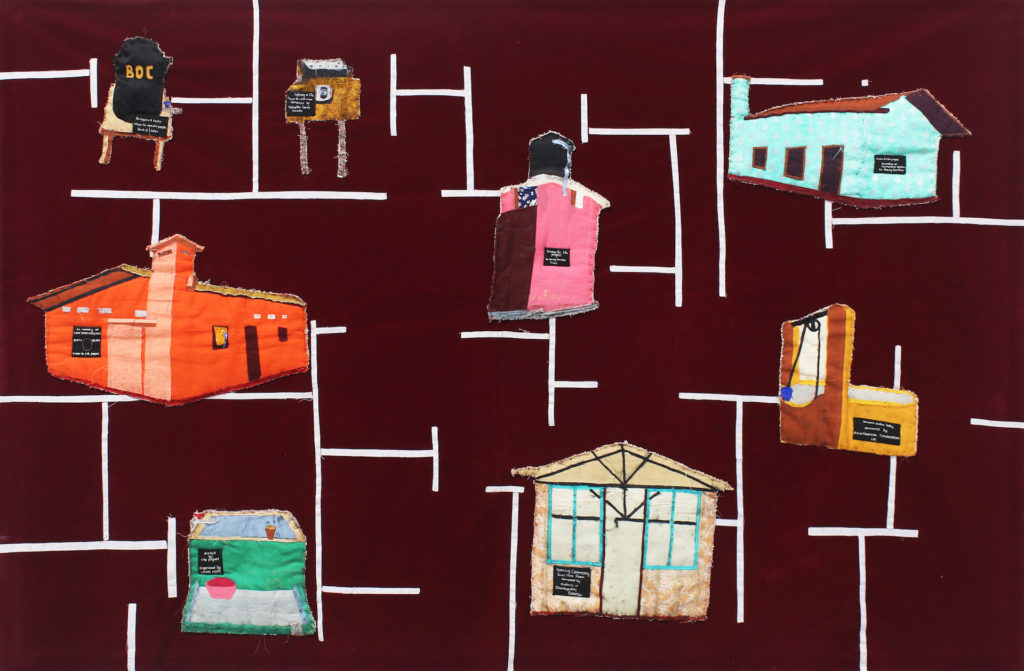Photos courtesy of Saskia Fernando Gallery
Hema Shironi’s solo exhibition Families ‘Not’ in the List at the Saskia Fernando Gallery delves into the complex and often painful histories of colonization, civil war, displacement and migration, all of which are intricately woven into the fabric of Hema Shironi’s art practice. By drawing from personal stories and lived experiences, Shironi crafts a compelling narrative that resonates with both individual and collective memories.
Hema Shironi’s work is characterized by her use of embroidery, mythological imagery, national symbols, bricolage and installation to explore cultural identity. Her distinctive approach involves the use of found materials, mismatched fabrics and loose threads, which she skillfully combines to document and question the ever-evolving socio-political landscape of her country.
In Families ‘Not’ in the List, Shironi uses intricate stitching and embroidery on fabric to explore the circumstances of communities historically overlooked. Her work reflects on the concept of home, portraying it as both a sanctuary and a void, capturing the delicate balance between safety and emptiness. This exhibition weaves together Shironi’s personal journey with the broader experiences of displaced communities, offering a poignant commentary on the impact of conflict and loss of identity.
Memory plays a crucial role in Shironi’s work, grounded in the experiences of migration and displacement that marked her childhood. The practice of embroidery, passed down through generations of maternal figures in her family, becomes a powerful tool in her hands, used with precision and care to recount a melancholic personal and familial history. Shironi’s nuanced understanding of home is deeply influenced by the uprootedness she has witnessed and experienced, both personally and within the communities around her. This concept of home is visually represented through gridded structures reminiscent of house foundations, offering a visual metaphor for the fragility and impermanence of belonging.
Hema Shironi spoke to Groundviews about her new exhibition.
What was your inspiration for this exhibition?
Before this exhibition, I was working on another exhibition called “Rented Shadow and Neighbours.” That was my first solo exhibition. I’m not working with a team. While I work, if I feel that certain pieces fit within a particular theme, I separate them. It’s a personal process. This journey started after I completed my BA and settled in Kilinochchi. I couldn’t find artistic materials, so I began working with what was available. This was around 2017 or 2016, right after my graduation. Initially, I started with drawing and then moved on to gathering materials like fabric. Other mediums were difficult to handle because my hands would always get sweaty but fabric was easier to work with and I didn’t need to travel far to get it. My family, especially my mother and grandmother, were skilled in tailoring, so fabric was always available at home. That’s how I started working with fabric as my medium.
Why is the idea of home important in your work?
For me, home isn’t just a structure. I’ve moved between more than 15 houses within the country. I’m still renting and I don’t have a permanent address. So home is more about memories and incidents that happened in those places. I associate certain homes with particular life events, like where I completed my scholarship or the neighbours I knew. Home is connected to emotion and family, feeling safe within four walls, whether it’s made of fabric or concrete. Without family, a place never really feels like home. That’s why I started reflecting on these themes in my artwork.
What is the significance of the many small homes that are in your work?
Yes, the stories are different but the theme of home connects them all. Take the piece with the female figures, for example, that represents my mother and grandmother during their pregnancies. It also references the gas explosions that were happening in homes during COVID times. My husband would warn me not to go into the kitchen when he left for work as it wasn’t safe. For my mother, during her pregnancy, she didn’t have a safe place to stay and had to wait for my father to come and get her. My grandmother also faced many challenges, including losing six children due to the civil war. So the concept of home for them and for me is intertwined with these stories of survival, change and loss. It’s deep and it’s about more than just a house.
What does the cage represent?
The cage represents how homes can sometimes feel like cages, especially for those who are left behind or forgotten by NGOs or government sectors. The structures may be built but they remain incomplete and the people have to live in those conditions. It’s symbolic of how we sometimes have to fix things ourselves after others leave, both in a literal and emotional sense.
